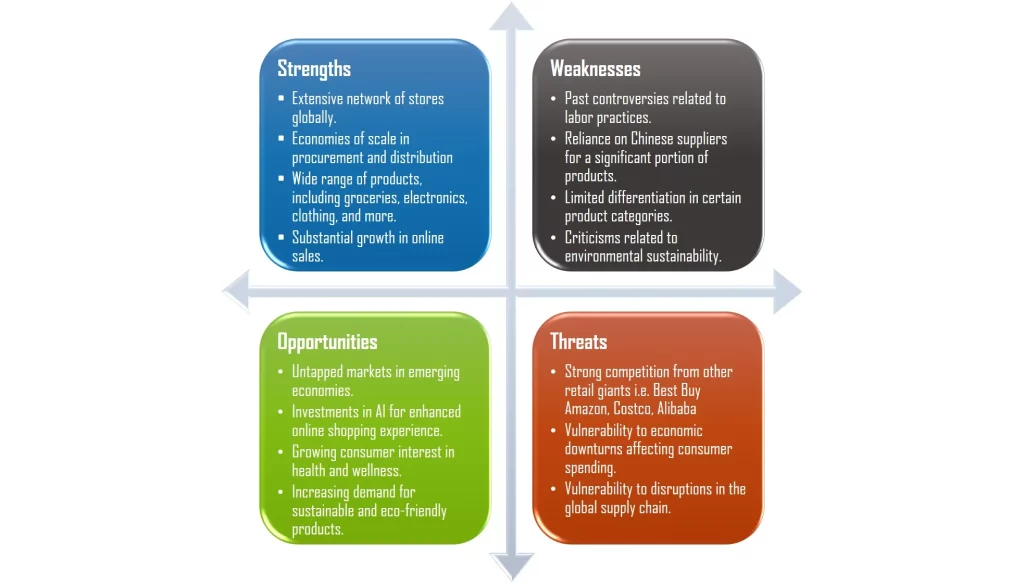
Below is a sample SWOT analysis essay on Walmart Inc. This example is intended to help students write better business analysis essays.
Walmart Inc. SWOT Analysis Essay
SWOT Analysis Essay Outline: Walmart Inc.
- Introduction:
- Company: Walmart Inc.
- Date of Establishment: July 2, 1962
- Founders: Sam Walton, Bud Walton
- Industry: Retail
- Stores: 10,586 stores in 24 countries
- Key People:
- Greg Penner (Chairman)
- Doug McMillon (President, CEO)
- Headquarters: Bentonville, Arkansas, United States
- No. of Employees: 2.3 million (2022)
- Type: Public
- Ticker Symbol: WMT (NYSE)
- Revenue: US $611.3 billion (2023); world’s largest company by revenue
- Net Income: US $11.29 billion (2023)
- Competitors: Best Buy, Amazon, Costco, Kroger, Target, Alibaba, Walgreens, Home Depot
- Strengths:
- Global Presence:
- Extensive network of stores globally.
- Strong market presence in multiple countries.
- Cost Leadership:
- Efficient supply chain management.
- Economies of scale in procurement and distribution.
- Diverse Product Portfolio:
- Wide range of products, including groceries, electronics, clothing, and more.
- Private label brands offering variety and affordability.
- E-commerce Growth:
- Substantial growth in online sales.
- Investments in technology and digital platforms.
- Weaknesses:
- Labor Practices Controversies:
- Past controversies related to labor practices.
- Issues related to employee satisfaction and treatment.
- Heavy Dependence on China:
- Reliance on Chinese suppliers for a significant portion of products.
- Vulnerability to geopolitical and trade uncertainties.
- Limited Differentiation:
- Perception of Walmart as a low-cost retailer.
- Limited differentiation in certain product categories.
- Environmental Impact:
- Criticisms related to environmental sustainability.
- Opportunities for improvement in eco-friendly practices.
- Opportunities:
- Expansion into Emerging Markets:
- Untapped markets in emerging economies.
- Opportunities for global expansion.
- E-commerce Enhancement:
- Continued growth in online retail.
- Investments in technology for improved online shopping experience.
- Health and Wellness Trends:
- Growing consumer interest in health and wellness.
- Opportunities in expanding product offerings in this category.
- Sustainability Initiatives:
- Increasing demand for sustainable and eco-friendly products.
- Opportunities for Walmart to lead in sustainability practices.
- Threats:
- Intense Retail Competition:
- Strong competition from other retail giants.
- Pressure to stay ahead in innovation and pricing.
- Economic Fluctuations:
- Vulnerability to economic downturns affecting consumer spending.
- Impact on sales of non-essential goods.
- E-commerce Competition:
- Intense competition in the online retail space.
- Pressure to compete with e-commerce giants.
- Supply Chain Disruptions:
- Vulnerability to disruptions in the global supply chain.
- Impact on product availability and distribution.
- Conclusion:
- Summary of key findings from the Walmart SWOT Analysis.
- Implications for Walmart’s strategic planning and future actions.
This SWOT Analysis outline provides a comprehensive framework for assessing Walmart’s internal strengths and weaknesses, as well as external opportunities and threats in the retail industry.

